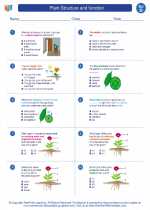Plant Structure and function -> spring force
Spring Force
The spring force is a type of force exerted by a spring when it is stretched or compressed. This force is a restoring force, meaning it always acts in the opposite direction of the displacement of the spring.
Understanding Spring Force
When a spring is stretched or compressed, it exerts a force that tries to bring it back to its equilibrium position. This force is proportional to the displacement of the spring from its equilibrium position, as described by Hooke's Law.
Hooke's Law
Hooke's Law states that the force exerted by a spring is directly proportional to the displacement of the spring from its equilibrium position. Mathematically, this can be expressed as:
F = -kx
Where:
- F is the spring force
- k is the spring constant (a measure of the stiffness of the spring)
- x is the displacement of the spring from its equilibrium position
Calculating Spring Force
To calculate the spring force, you can use Hooke's Law and the spring constant. The negative sign in the equation indicates that the force is always opposite to the direction of the displacement.
Example:
If a spring with a spring constant of 50 N/m is stretched by 0.2 meters from its equilibrium position, calculate the spring force.
F = -kx
F = -(50 N/m)(0.2 m)
F = -10 N
Therefore, the spring force is 10 N in the opposite direction of the displacement.
Applications of Spring Force
Spring force is encountered in various everyday objects and systems, such as:
- Suspension systems in vehicles
- Door hinges
- Trampoline springs
Study Guide
Here are some key points to remember about spring force:
- Spring force is a restoring force exerted by a spring when it is stretched or compressed.
- Hooke's Law describes the relationship between spring force, spring constant, and displacement.
- The spring force is always opposite to the direction of the displacement of the spring.
- Spring force can be calculated using the equation F = -kx, where F is the force, k is the spring constant, and x is the displacement.
- Spring force is encountered in various everyday objects and systems.
[Spring Force] Related Worksheets and Study Guides:
.◂Science Worksheets and Study Guides Fourth Grade. Plant Structure and function

 Worksheet/Answer key
Worksheet/Answer key
 Worksheet/Answer key
Worksheet/Answer key
 Worksheet/Answer key
Worksheet/Answer key
 Vocabulary/Answer key
Vocabulary/Answer key
 Vocabulary/Answer key
Vocabulary/Answer key
 Vocabulary/Answer key
Vocabulary/Answer key
 Vocabulary/Answer key
Vocabulary/Answer key
